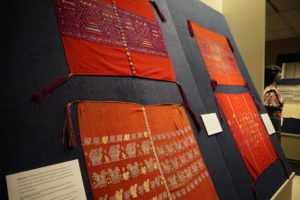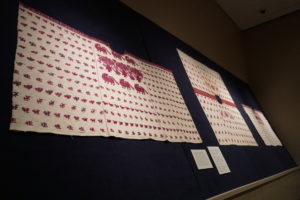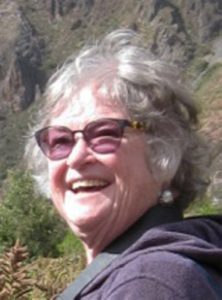Story by Kristin Breakell
Martha Egan, a collector and donor of Latin American textiles, will be speaking at CSU’s Avenir Museum of Design and Merchandising on Thursday, Oct. 20, at 7 p.m. She will talk about the intricacies of Guatemalan textiles as well as the process of collecting art.
Egan’s donations of textiles are currently featured as part of the “Layers of Meaning: Color and Design in Guatemalan Textiles” exhibition through Dec. 16 at the Avenir Museum. Egan’s talk is titled, “The Culture of Cloth Among Guatemala’s Highland Mayas.”

“Martha Egan’s donation greatly expanded our collection of Central American textiles,” said Megan Osborne, curator at the Avenir Museum. “Not only are the pieces of high quality, but they also represent a wide variety of highland villages in Guatemala. This type of well-documented, high-quality and wide-ranging collection is an asset to the students and faculty here at CSU. They will serve as tools for teaching both design and technique.”
Educational path
Egan began her journey at CSU. After taking a class on Latin American history taught by Professor Michael Riley, Egan chose to take her education to the next level.
“The professor was delightful and very knowledgeable,” she said. “The class woke me up. I realized that Mexico is the place to be in order to learn about the Spanish language and culture, so I traveled to Mexico and got my bachelor’s degree at the University of the Americas.”
In addition to her formal education, Egan’s ongoing independent research and travels have contributed to her vast knowledge about Latin American folk art.
“The way you learn about folk art, I believe, is to handle it. Be in physical contact with it as much as possible, visit its origins, and get to know the people who make it,” she said.
Egan took annual trips to Central and South America and began collecting art and textiles on each of her trips.
A 42-year history
She started collecting in the mid-’70s and has not stopped since. Egan has 42 years of experience as an importer and retailer of Latin American folk art and Spanish Colonial antiques, much of which she gained while operating a store called Pachamama (meaning “Earth Mother” in Kichwa, an indigenous South American language) with her sister and brother-in-law.

Now, as she is retiring and closing the store, Egan has decided to donate additional pieces from her collection of Guatemalan textiles to the Avenir Museum.
“Tradition is disappearing into the jeans and T-shirt culture,” she said. “I know it won’t be around for very long, so I’m happy to donate examples of really fine weavings from the past. Guatemalan weavers are astonishing, and the Avenir collection doesn’t have much Latin American textiles and clothing. I chose to donate pieces I thought would be of interest to students because of the materials and techniques, and I intend to give more.”
“Collections like Martha’s enable us to engage students in textile research that can then be used in a professional museum setting,” said Osborne. “Many of the pieces featured in ‘Layers of Meaning’ were research projects for students in AM 460 – Historic Textiles. We are always excited when we can expose students to global textile traditions, and in turn they can see the real-world application of their classroom research in the Avenir galleries.”
‘I love it all’
Egan’s passion and respect for each piece that she donated is evident in the way she speaks about the collection. When asked what her favorite piece is, she responded, “It’s like asking a mother which one is her favorite child. I love it all, I really do. The weavings are a tribute to their weavers and the quality of their craftsmanship. Each one of them has its own character.”
 Egan has accumulated an incredible amount of experience in the field of Latin American history throughout her life. She has written articles for magazines and museum catalogues, published two books on Latin American folk art (Milagros: Votive Offerings from the Americas, 1991 and Relicarios: Devotional Miniatures from the Americas, 1993), and continues to write and speak at universities and museums across the United States and Europe.
Egan has accumulated an incredible amount of experience in the field of Latin American history throughout her life. She has written articles for magazines and museum catalogues, published two books on Latin American folk art (Milagros: Votive Offerings from the Americas, 1991 and Relicarios: Devotional Miniatures from the Americas, 1993), and continues to write and speak at universities and museums across the United States and Europe.
“It’s been a wonderful, long journey,” she said.
To learn more about Egan’s journey and gain a deeper understanding of traditional Guatemalan textiles, visit the Avenir Museum of Design and Merchandising, 216 E. Lake St., on Thursday, Oct. 20, at 7 p.m. Come early to see “Layers of Meaning” and other current exhibitions at the Avenir Museum. More information and directions can be found at www.avenir.colostate.edu.
The Avenir Museum is part of the Department of Design and Merchandising in CSU’s College of Health and Human Sciences.